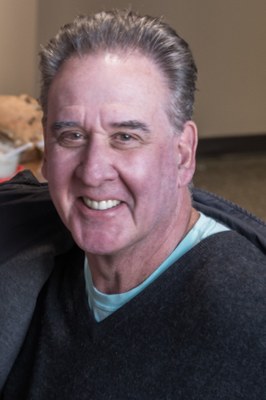Robert Buchanan, Ph.D.
Education:
B.A., Chemistry, Western Maryland College (McDaniel College); 1973
Ph.D., University of Colorado; 1980
Postdoctoral Fellow, Massachusetts Institute of Technology; 1981-1982
Curriculum Vitae
Current Position:
Professor, Department of Chemistry
Contact Information:
Department of Chemistry
University of Louisville
2320 South Brook Street
Louisville, KY 40202
Phone: 502-852-6970
Email: bob.buchanan@louisville.edu
Website Link
Research Description:
Bis(thiosemicarbazone)copper(II) complexes (CuBTSC) have shown great potential as imaging agents and new treatments for treating neurodegenerative diseases, including amyotrophic lateral sclerosis (ALS), as well as antitumor, antiviral, antibacterial, and antifungal agents. The accepted mechanism for their diverse biological activities is that the BTSC ligand acts as an ionophore that carries copper across cellular membranes delivering it to the inside of certain cells. Depending on the Cu(II)/Cu(I) redox potential of the complex, the bound Cu(II) can be reduced to Cu(I) and released from the ligand inside cells with sufficiently reducing intracellular environments, which can include cancer cells and ALS-affected neurons. Selective delivery and retention of copper inside diseased cells vs. healthy cells can be useful for imaging or treatment of disease. For most copper(II) BTSC complexes, the translation of promising preclinical results into clinical applications has been hindered by a narrow therapeutic window and uncertainties about their mechanism of action. To overcome these limitations, we have synthesized and characterized a library of copper(II) complexes based on novel BSTC, bis(alkylthiocarbamate), and hybrid thiosemicarbazone-alkylthiocarbamate scaffolds. Our preliminary studies indicate that small changes in molecular structure of the ligands can lead to significant changes in the cytotoxicity of their copper complexes toward cancer cells and in their selectivity for cancer cells compared to non-cancer cells. We have identified several complexes that inhibit cancer cell proliferation in the low nanomolar range and that are at least 20-fold more active against cancer cells compared to non-cancer cells.
Recent/Notable Publications:
- Phipps CA, Hofsommer DT, Zirilli CD, Duff BG, Mashuta MS, Buchanan RM, Grapperhaus CA. Metal-ligand cooperativity promotes reversible capture of dilute CO2 as a Zn(II)-methylcarbonate. InorganicChemistry 2023 Feb 13;62(6):2751-2759. doi: 10.1021/acs.inorgchem.2c03868 . Epub 2023 Jan 30. PMID: 36715745.
- Phipps CA, Hofsommer DT, Toda MJ, Nkurunziza F, Spurgeon JM, Kozlowski PM, Buchanan RM, Grapperhaus CA. Ligand-centered hydrogen evolution with Ni(II) and Pd(II)DMTH. Inorganic Chemistry 2022 Jun 27;61(25):9792-9800. doi: 10.1021/acs.inorgchem.2c01326 . Epub 2022 Jun 10. PMID: 35687329.
- Bajaj K, Andres SA, Hofsommer DT, Galib M, Mashuta MS, Narayanan B, BuchananRM, Bates PJ, Grapperhaus CA. Investigations of bis(alkylthiocarbamato)copper linkage isomers. Inorganic Chemistry 2022 May 23;61:7715-7719. doi: 10.1021/acs.inorgchem.2c00371 . Epub 2022 May 12. PMID: 24439215.
- Bajaj K, Buchanan RM, Grapperhaus CA. Antifungal activity of thiosemicarbazones, bis(thiosemicarbazones), and their metal complexes. Journal of Inorganic Biochemistry 2021 Dec;225:111620. doi: 10.1016/j.jinorgbio.2021.111620. Epub 2021 Sep 25. PMID: 34619407. (review)
- Cronin SP, Strain JM, Mashuta MS, Spurgeon JM, Buchanan RM, Grapperhaus CA. Exploiting metal-ligand cooperativity to sequester, activate, and reduce atmospheric carbon dioxide with a neutral zinc complex. Inorganic Chemistry 2020 Apr 6;59(7):4835-4841. doi: 10.1021/acs.inorgchem.0c00121 . Epub 2020 Mar 20. PMID: 3219392.
- Andres SA, Bajaj K, Vishnosky NS, Peterson MA, Mashuta MS, Buchanan RM, Bates PJ, Grapperhaus CA. Synthesis, characterization, and biological activity of hybrid thiosemicarbazone-alkylthiocarbamate metal complexes. Inorganic Chemistry 2020 Apr 6;599(7):4924-4935. doi: 10.1021/acs.inorgchem.0c00182. Epub 2020 Mar 11. PMID: 32159342.
- Gupta A, Vishnosky N, Hietsoi O, Losovyj Y, Strain J, Spurgeon J, Mashuta M, Jain R, Buchanan R, Gupta G, Grapperhaus C. Effect of stacking interactions on the translation of structurally related bis-thiosemicarbazone Ni(II) HER catalysts to modified electrode surfaces. Inorganic Chemistry 2019;55:12025-12039. doi: 10.1021/acs.inorgchem.9b01209. Epub 2019 Sep 3. PMID: 31479262.
- Gulati S, Hiertsoi O, Calvary CA, Strain JM, Pishgar S, Brun C, Grapperhaus CA, Buchanan RM, Spurgeon JM. Photocatalytic hydrogen evolution on Si-photocathodes modified with bis(thiosemicarbazonato)nickel(II)/Nafion. Chemical Communications (Camb.) 2019 Aug 7;55(64):9440-9443. doi: 10.1039/c9cc04117f. PMID: 31328206.
- Jain R, Mamun AA, Buchanan RM, Kozlowski PM, Grapperhaus CA. Ligand-assisted metal-centered electrocatalytic hydrogen evolution upon reduction of a bis(thiosemicarbazonato)Ni(II) complex. InorganicChemistry 2018 Nov 5;57(21):13486-13493. doi: 10.1021/acs.inorgchem.8b02110. Epub 2018 Oct 12. PMID: 30351080.
- Haddad AZ, Cronin SP, Mashuta MS, Buchanan RM, Grapperhaus CA. Metal-assisted ligand-centered electrocatalytic hydrogen evolution upon reduction of a bis(thiosemicarbazonato)Cu(II) complex. Inorganic Chemistry 2017 Sep 18;56(18):11254-11265. doi: 10.1021/acs.inorgchem.7b01608. Epub 2017 Aug 31. PMID: 28857556.
 Facebook
Facebook Twitter
Twitter Linkedin
Linkedin